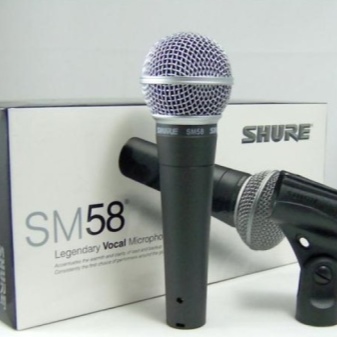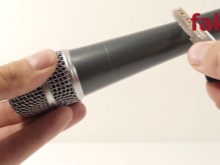Shure microphones: features, model overview, selection criteria

Shure microphones are popular among amateurs and professionals alike. It is very important to understand the features of such a brand and make a brief overview of the models. This will allow you to more accurately and correctly apply the main selection criteria.
Peculiarities
Analyzing the nuances of Shure microphones, one should focus on the fact that they have been used for a very long time and in large quantities. It is difficult to find a more common brand of microphone technology. Many models have become true legends of audio technology. Reviews have generally noted the excellent reliability and mechanical strength of Shure microphones. Many people say openly: they do not show any flaws even after prolonged use.
The company's specialists are able to achieve excellent sound in both female and male vocals. The sound quality in general does not give rise to complaints. Problems, however, can be associated with a large number of counterfeits. But this is not a reason to refuse a purchase - you just need to be more careful. The original versions always have an excellent value for money.



Model overview
Consider modifications of Shure microphones to start with a true "legend" even among this brand. It's about version SM58. The cardioid device is ideal for warm vocals. The sound is recorded very clearly and cleanly. Convenience is provided by the stand holder. But this is completely forgotten when they start using the device.
At such a moment, an intense decay in the low and middle frequencies is immediately detected. The excellent system of pneumatic shock absorption is also good news. The positive emotions of a number of users are also associated with the built-in pop filter. The range is 0.05 to 15 kHz.
There is an excellent wind protection system.


A good alternative is a studio microphone. SM7B. The cardioid device guarantees balanced sound in a full-fledged studio environment. The designers took care of the successful suppression of electromagnetic interference. The delivery set contains a removable windscreen. The bracket is mounted so that it is easy to control the position of the microphone.
The technical characteristics are as follows:
- weight 0.765 kg;
- working range from 0.05 to 20 kHz;
- it is possible to switch the low-pass filter;
- no attenuator and replaceable capsule included;
- almost total suppression of mechanical noise.


When choosing a model with a supercardioid sound distribution diagram, you should pay attention to BETA 58A... Experts appreciate the adapted frequency response. The damper suppresses unwanted noise as efficiently as possible. Prevents negative feedback effects and off-axis sounds. Neodymium magnet provides excellent signal-to-noise ratio.
It is also helpful to note:
- hardened steel alloy grating, which has little wear;
- minimal impact of changes in resistance level on sound quality;
- 3-pin XLR connector;
- weight 0.278 kg.


Shure wireless microphones are also popular, including PG58. This capsule is useful for many other wireless systems. The model is mainly used for speech transmission, vocals and for karaoke performance. In all variants, the work is organized according to an analog method. The radius of action can be up to 100 m.


You should also pay attention to the hand-made radio microphone. FP2 / VP68. It can operate in the transmission range from 736 to 754 MHz.There are 10 fixed channels. The body is made of plastic, but at the same time it is quite strong and stable. Switching on and off is indicated by an indicator light.
Other features:
- work from a pair of AA batteries for 12 hours;
- capacitor version;
- pie chart of reception;
- the presence of a clip (a special holder for microphone stands);
- transmission radius up to 100 m;
- 20 simultaneously served receiving points;
- sensitivity at 41 dB;
- weight 0.29 kg.


How to distinguish from a fake?
The popularity of Shure technology makes this question very relevant for anyone interested in acoustics, at least at the amateur level. It is imperative to think if the seller is offering too low a price. Buying a microphone off hand is definitely not the best option. But even when contacting a reputable store, it is very important to require certificates of conformity and accompanying documents. Attention: it is worth checking whether real photographs are used for illustrations or not. The most common trick is a shot in which the microphone is positioned with the switch down.
The full model name that appears on the price tag or on the microphone itself must match the name on the Shure official website. It is also useful to know that:
- the original version cannot have Caution;
- A genuine Shure microphone always has a Thread Adapter section on its sticker;
- the cable is included in the package of counterfeit models only;
- there is a marked difference in thread quality.



Criterias of choice
When analyzing microphone performance, don't pay too much attention to sensitivity. Rather, it is important, but only in conjunction with protection against noise and interference. Otherwise, a highly sensitive system will inevitably record a lot of extraneous sounds. Radio transmitters can be stationary or mobile. The second option is recommended to use where it is impossible to connect to the mains, or the power supply is unstable.
Handheld or integrated mobile transmitters are preferred for vocal performances. In other cases, for example, for a conference or other event, it is more correct to use stationary devices. Important: the microphone volume must be selected reasonably to suit the room or open area. You can not use both frankly weak and deafening systems.
For singers (both professional and amateur), cardioid and supercardioid microphones are best suited.

The bi-directional device is suitable for those who want to record the emotions and reactions of the audience along with their own performance. He is also recommended for duet performances, interviews or conversations with 1-2 invited guests. Omnidirectional microphones provide surround sound and do not interfere with the noise of the recording. They are used at concerts and at joint rehearsals. Also, the omnidirectional microphone is useful when you need to record all the sounds characteristic of a place or event, accurately recreate its atmosphere.
It is also worth paying attention to the amplitude-frequency response. If the performer's voice is high-pitched, but not too harsh, the "blockage on the top" is simply not needed. But for a velvety baritone, it is quite acceptable, although not required. With regard to the sound pressure level, this figure indicates the number of decibels going without distortion. And the most important nuance: for all the importance of digital indicators, one must also take into account one's own impressions:
- the convenience of the microphone (how to hold and move it);
- lightness of the model;
- own assessment of sound quality.


See below for a comparison of microphones of different models.













The comment was sent successfully.